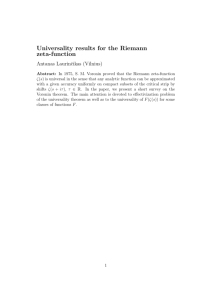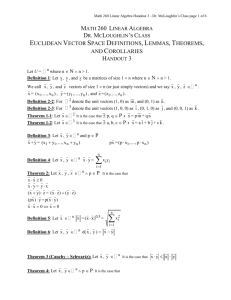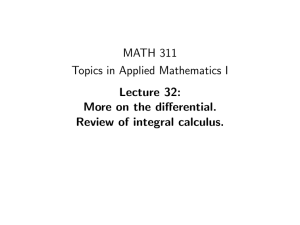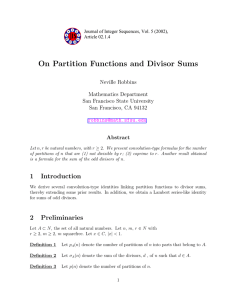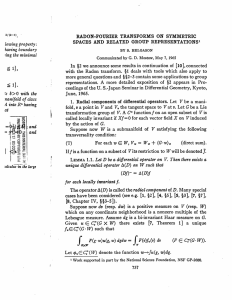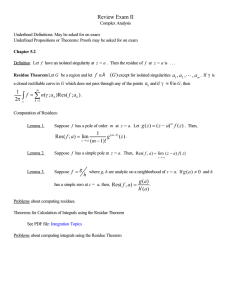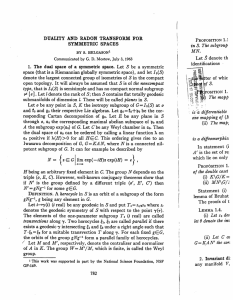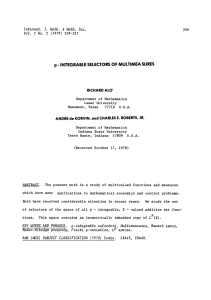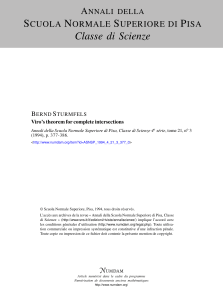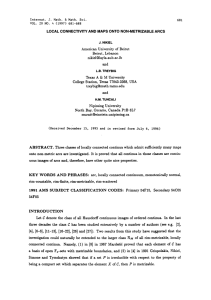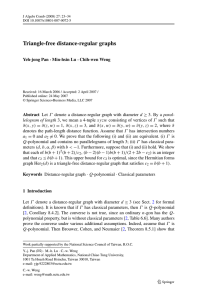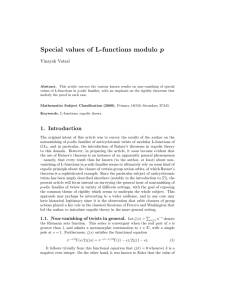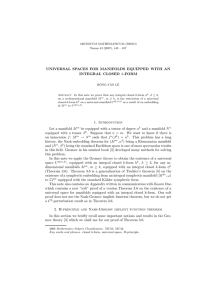A Closure Problem Related to the Riem Ann Zeta
advertisement
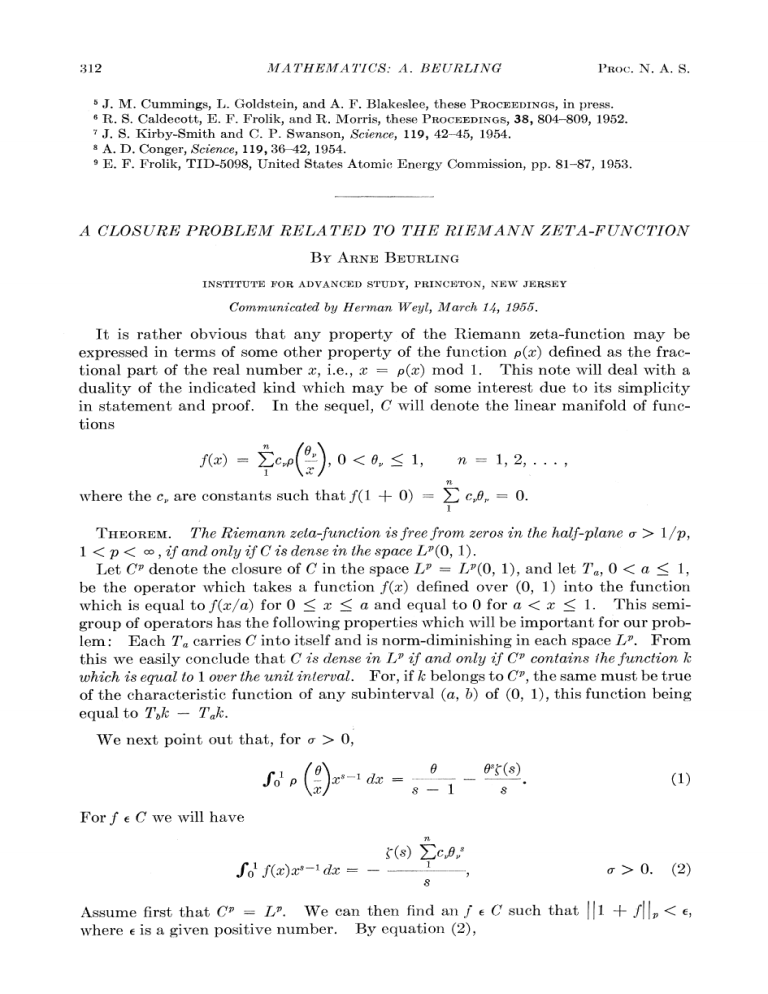
in press. J. M. Cummings, L. Goldstein, and A. F. Blakeslee, these PROCEEDINGS, R. S. Caldecott, E. F. Frolik, and R. Morris, these PROCEEDINGS, 38, 804-809, 1952. J. S. Kirby-Smith and C. P. Swanson, Science, 119, 42-45, 1954. A. D. Conger, Science, 119, 36-42, 1954. E. F. Frolik, TID-5098, United States Atomic Energy Commission, pp. 81-87, 1953. CLOSURE PROBLEM RELATED TO THE RIEMANN ZETA-FUNCTION BY ARNE BEURLING INSTITUTE FOR ADVANCED STUDY, PRINCETON, NEW JERSEY Communicated by Herman Weyl, March 14, 1955. It is rather obvious that any property of the Riemann zeta-function may be Dressed in terms of some other property of the function p(x) defined as the fracnal part of the real number x, i.e., x = p(x) mod 1. This note will deal with a ality of the indicated kind which may be of some interest due to its simplicity statement and proof. In the sequel, C will denote the linear manifold of funcYns 0 < f(x) -= zECIp n = 1, 2,..., i 1, n Lerethe c, are constants such that f(i + 0) = cO,,c= 0. The Riemann zeta-function is free from zeros in the half-plane a > 1/p, ' p < oo, if and only if C is dense in the space LP(O, 1). Let CP denote the closure of C in the space L" = L"(0, 1), and let Ta, 0 < a < 1, the operator which takes a function f(x) defined over (0, 1) into the function lich is equal to f(x/a) for 0 < x < a and equal to 0 for a < x < 1. This semiup of operators has the following properties which will be important for our probn: Each Ta carries C into itself and is norm-diminishing in each space LP. From is we easily conclude that C is dense in LP if and only if C" contains the function k ich is equal to 1 over the unit interval. For, if k belongs to CP, the same must be true the characteristic function of any subinterval (a, b) of (0, 1), this function being ual to Tlk - Tak. THEOREM. We next point out that, for a > 0, fo p -)x dxc --O - S-1 \X/ (1) ---.s) S ,r f e C we will have n c(s) Zcr6A" fol f(x)xs-l dx = ----0. > (2) ;sume first that CP = L'. We can then find an f e C such that Ill + fi p < e, By equation (2), lere e is a given positive number. o'(I + f(x)) Xs-' dx = - (s) ZCvs) ( a > 0. (3) r > l/p, Holder's inequality yields the following majorant of equation (3) 11 + fllll xllq'< q(- ' l/p) nsequently, n c D(s) Il - -s ^c^iEI c s < < -q's ( q(a l/p)' o >l/p. (4) is proves that v 7 0 in the region Dp, where the right-hand member of relation is < 1, i.e., for 1 a> - + p eq Islq q e 0, Dp,, increases and exhausts the half-plane c > 1/p. We should also obve at this instance that Dp, e is convex and that its boundary intersects the line = 1 at the two points where Is = 1/e. Phe proof of the necessity of the condition CP = LP is less trivial. If C is not ise in LP, we know by a classical theorem of F. Riesz and Banach that the dual .ce Lq must contain a nontrivial element g which is orthogonal to C in the sense It 0 = fol g(x)f(x) dx, feC. (5) 0 < a < 1. (6) 0ceTa takes C into itself, it follows that 0 = folg(x)Taf(x) dx = afol g(ax)f(x) dx, feC, Es, 1 < r < q, be the closed linear subset of LI spanned in the topology of btspace by the set g(ax), 0 < a 1 }. From equation (6) and the fact that C isists of bounded functions, we conclude that each f e C is orthogonal to each Lctionbelonging to any of the sets Eg. We now recall that the positive reals < 1 m a semigroup S under multiplication and that each continuous (and normali) character of S has the form p = xX, where X is an arbitrary complex or real mber. Clearly s e Lqif and only if (R(X) > - 1/q. The problem of whether or not et of the kind EP contains a character is of considerable complexity. It has mnstudied earlier by the author', 3 and by Nyman.2 However, the following ret3 can be proved by elementary function theoretic means: Let g(x) belong to a ice LQ(O, 1), 1 < q < o, and have the property fS x > O. Ig(x) dx > O, en there exists at least one character xX, (Re(X) > Egfor 1 < r < q (but not necessarily in E'). (7) l/q, which is contained in each Cnorder to apply this theorem, we have first to show that condition (7) is satisfied our function g. For this pupose assume that g vanishes a.e. on some interval a), a > 0. Choose b such that a < b < min (1, 2a), and f(x) = bp(a/x) - (b/x). Thisf belongs to C; it vanishes for x > b and takes the value a for a < x < Therefore, 0 = fo'f(x)g(x) dx = afa g(x) dx, a < b < min (1, 2a), (8) d it follows that g = 0 a.e. for x < min (1, 2a). On repeating the same argument nite number of times, we find that g = 0 a.e. over (0, 1), which is a contradiction. Lecited theorem may thus be applied to g and yields the existence of a number R,e(X)> - l/q, such that xXis orthogonal to C. On defining So = 1 + X, we will ve, in particular 0 == o p()- (p(0)) ( Osi xS?-x ) (so), 0 < 6< 1. (9) )viously, so 7 1. Since 0 can be chosen such that, at any given point # 1, 06-1 7 0, it follows that so is a zero of P'. We also have 6e, (So) > 1 - q = l/p, and this concludes the proof. We finally point out that the problem of how well k = 1 can be approached by ictions e C has a direct bearing on the distribution of the primes even in case toes have zeros arbitrary close to the line a = 1. A. Beurling, "On Two Problems concerning Linear Transformations in Hilbert Space," Acta ath., Vol. 81, 1949. B. Nyman, "On Some Groups and Semi-groups of Translations" (thesis, Uppsala, 1950). A. Beurling, "A Theorem on Functions Defined on a Semi-group," Math. Scand., Vol. 1, 1953. rTEGRABLE AND SQUARE-INTEGRABLE REPRESENTATIONS SEMISIMPLE LIE GROUP OF A BY HARISH-CHANDRA DEPARTMENT OF MATHEMATICS, COLUMBIA UNIVERSITY Communicated by Paul A. Smith, March 11, 1955 Let G be a connected semisimple Lie group. We shall suppose for simplicity at the center of G is finite. Let w7be an irreducible unitary representation of G a Hilbert space ,5. We say that ir is integrable (square-integrable) if there ists an element V # 0 in ~ such that the function (A, r(x) /) (x e G) is integrable quare-integrable) on G, with respect to the Haar measure. Assuming that the aar measure dx has been normalized in some way once for all and that 7ris squarelegrable, we denote by d, the positive constant given by the relation' f n nt ) ,tr n dx iere V is any unit vector in ,. Let C, (G) denote the set of all complex-valued nctions on G which are everywhere indefinitely differentiable and which vanish Itside a compact set. Then the following result is an easy consequence of the ;hurorthogonality' relations.




